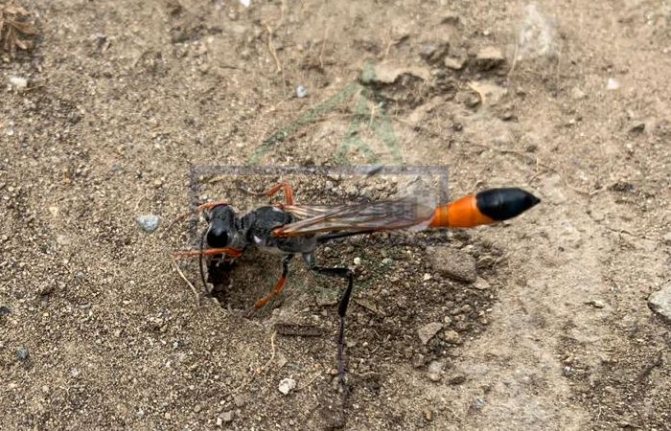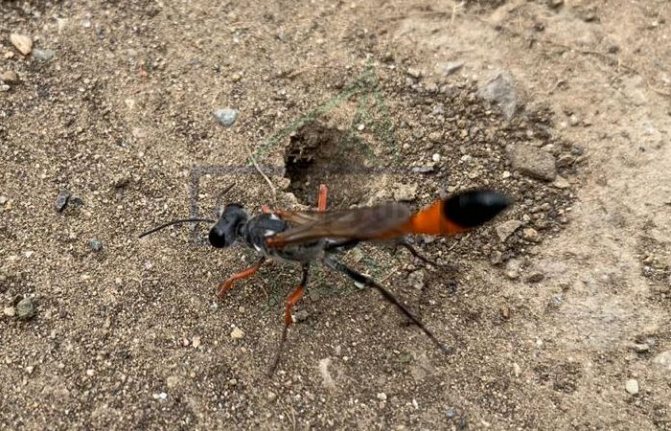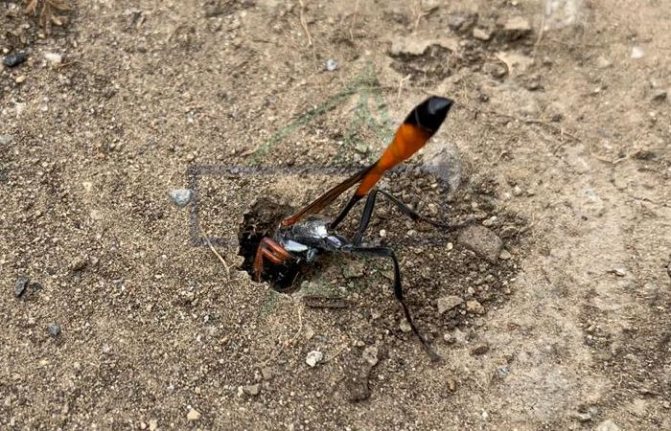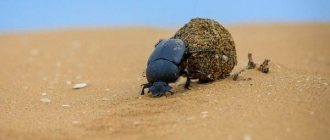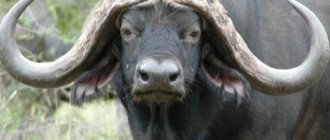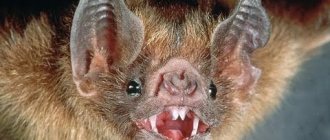The wasp-wasp differs significantly in appearance from the well-known insects with a sting and a yellow-black abdomen. She also leads a different way of life, has a smaller size and a different structure. There are more than 100 thousand species of these insects on the planet, but in Russia you can find single representatives of the family. The wasp is a parasite. She lays her eggs on the body of other insects, and the hatched larvae live directly in the host's body. Many are interested in the question of whether the wasp is dangerous, what harm and benefit it brings to humans. We will talk about this in our article.
Insect riders: general information
The description of these parasites is quite interesting. The variety of forms of insects is combined with an abundance of their varieties. The largest species reaches 5 cm in length, and the smallest - up to 0.5 mm. Riders have long antennae, their bodies are very thin. They are often black with gold and red patterns. Most pests have colorless wings, but wingless specimens can also be found. The females on the dorsum carry the ovipositor, which may even exceed the length of their body.
The main characteristics of the wasp
The insect belongs to the family of Hymenoptera. A characteristic feature of individuals is the presence of the so-called "wasp waist". The abdomen and sternum are connected by a small thin plate.
Taurus consists of three parts:
- heads;
- sternum;
- abdomen.
The wings are divided into two sections. The front is always larger than the back. The wings are thin and transparent, with translucent veins. In some individuals, they shimmer in the sun and acquire a purple hue.
There is a sting in the lower part of the abdomen. It looks like a thin needle. The sting connects to a special gland that produces poison. Depending on the type of wasp, the toxicity of the excreted substance also differs.
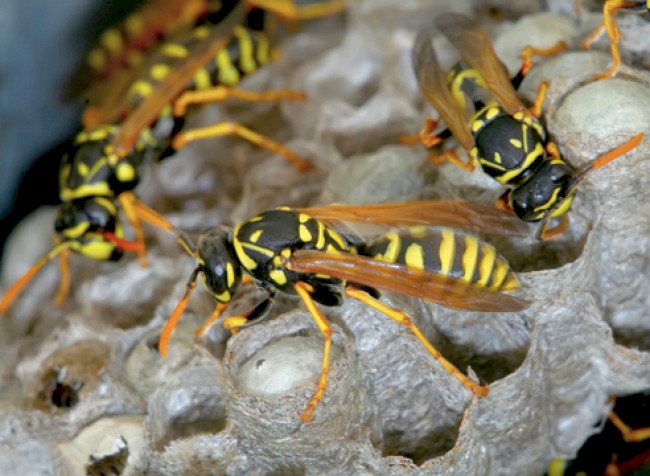
Individuals use a sting in several cases:
- to protect the nest;
- as self-defense;
- to immobilize the enemy.
The feet are in five parts. Antennae is used for orientation in space. They pick up any sounds and also react to smell. Most wasps are yellow-black or orange-black in color.
The jaws are covered with chitin. It is a very solid substance. Wasps are dangerous to other species, as they can bite through the shell of their enemies.
Egg laying process
Such parasites are treasure hunters by their nature. Distinguished by an excellent instinct, they run along the dried-up pillars of trees and look for under the bark of walled up larvae of longhorn beetles, gold beetles. From time to time, wasps (insects) fly around the trunk in a curve, looking for the place where a large beetle larva was buried under the bark. And it's even difficult to imagine how they can feel the larva through such a dense bark.
Having found the area, the parasite settles on the pine bark and begins to pierce it with the ovipositor. Therefore, in most wasps, the ovipositor is of enormous length, in some species it is even 7.5 times longer than the body. This is a whole drilling device. At first, the insect removes the "cover", in which its "installation" was preserved, to the side, then it stands "on tiptoe" and slowly twists a thin sting into the bark. Along with this, the parasite is brought to spin, screwing the ovipositor deeper.
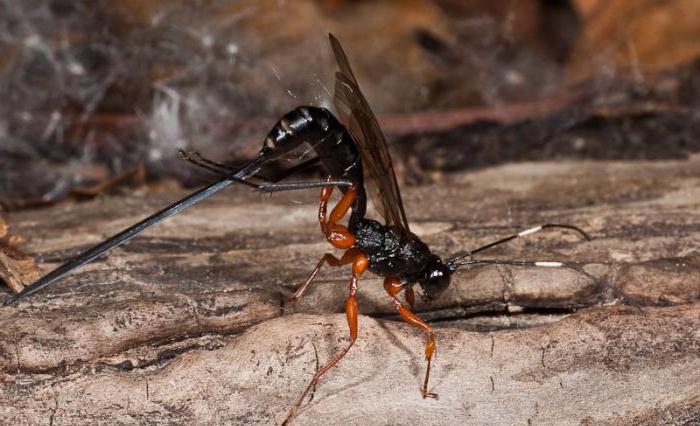

The drilling operation sometimes lasts several hours.Due to its special structure, the thin ovipositor easily goes through the thick bark of the tree, piercing the hidden prey larva at a depth of 2-3 cm. Then the egg passes through this ovipositor.
Reproduction and life expectancy
After reaching adulthood, riders do not live long, usually no more than three months. And only in cases when, during the period of completion of their formation, they are overtaken by cold weather, they go to a forced wintering, and in the spring they complete their life cycle and die. In this case, their lifespan can be up to ten months. Each species approaches reproduction in an individual way.
After mating, the female Ephialt wasp has to look for a suitable barbel larva in the bark of the tree. To do this, she runs along the trunk and taps everywhere with her antennae. From this sound, she locates the object.
Then she drills the wood with the ovipositor, standing on her hind legs, twirling them like a top. This work takes at least two hours. When it reaches the larva hidden in the trunk, the parasite places a single egg in it.
The number of eggs of small species from the Braconid family reaches 20 pieces. Caterpillars, which are their main carriers, are paralyzed by poison. Less than a day after the attack, the larvae appear.
They complete all stages of formation in five days, and pupation lasts another four days. But developing rapidly, such creatures live extremely little: males - no more than 10 days, and the female half - only a month.


Large poachers can infect ladybirds by placing an egg inside. In this case, the development of the face is slower, sometimes more than three weeks. It feeds on the connective and fatty tissues of the cow.
And at a certain time he leaves the body, but not the victim. In this case, the larva gnaws at the motor nerves and paralyzes the ladybird. Further, a cocoon coils under it. Thus, about a week passes in the pupa stage, and then the tormentor forever goes into adulthood.
Types of riders (insects)
There are many varieties of such parasites: very small (less than 1 mm) and rather large (more than 2 cm). Some have an ovipositor several times wider than itself, while others are tiny. There are individuals that destroy the eggs of pests, and other species parasitize on living larvae, even spend the winter in them. Some paralyze the victim before laying eggs, others do not.


Most adult insects feed on pollen of flowers (phacelia, dill), nectar, prey hemolymph, or sweet secretions of aphids. Many species do not feed at all, as they have formed eggs that only need to be laid. Of course, the female lays eggs, and the ovipositor is only hers.
Varieties
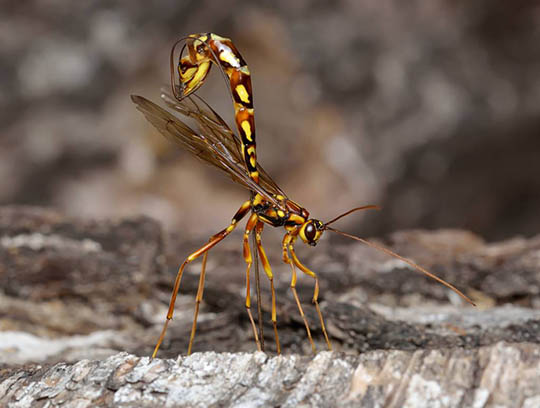

Megarhyssa perlata
Mutillides are represented by about 4 thousand varieties. The habitat is mainly in the steppe regions. In males, larger than females (their length is up to 3 cm), the color is dark brown or black, in the female - orange or bright red with black blotches. The body is covered with thick long hairs. Females have no wings, so they are called velvet ants. Unlike other species, they have a long sting, with which they fight the owners of the nests, where they are going to lay eggs in their larvae.
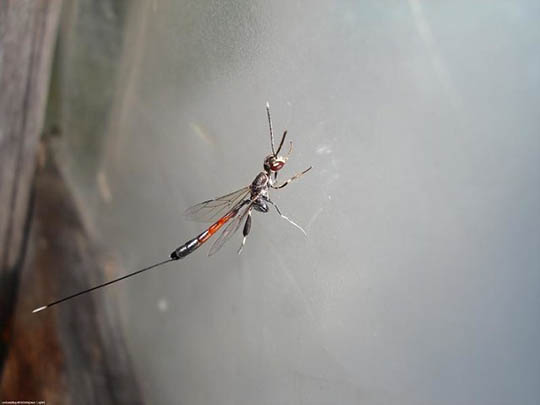

Mutillidae
Pompilids, or road wasps, are found in almost all regions of the world, but they are especially fond of hot climates. There are up to 4900 species of them. Their brown or black body is up to 4 cm long, and females pull their ovipositor into an elongated narrow abdomen. The second name is explained by the fact that they arrange their burrows near the roads. For laying eggs, females use large spiders.
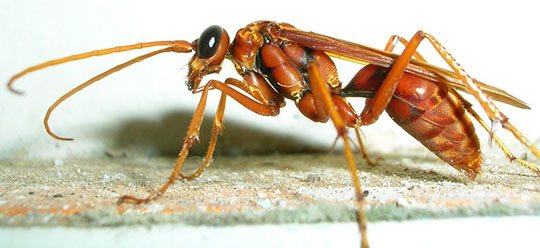

Pompilidae or Psammocharidae
Crabronids, or sand wasps, make their nests in the sand. Of more than 8 thousand representatives of this species, about 600 are found in Europe.In appearance, due to black and yellow stripes, as well as small (up to 2 cm) size, they resemble simple wasps, have the same well-formed wings and short antennae.
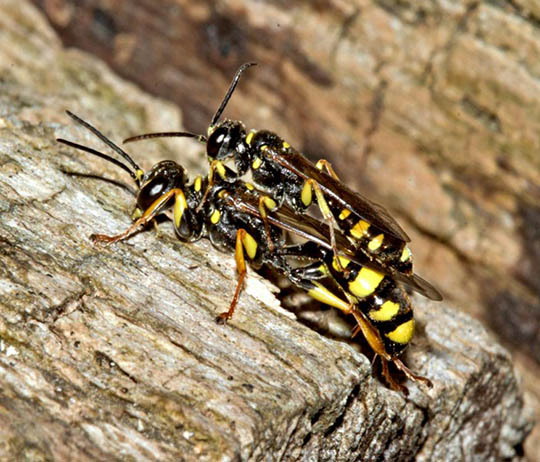

Crabronidae
Scephids are represented by 800 species that live mainly in warm climates. Their dark body reaches up to 6 cm in length. They build nests in the sand or sculpt on the walls of buildings. To lay eggs, the female finds a prey, paralyzes it and transfers it to her nest.
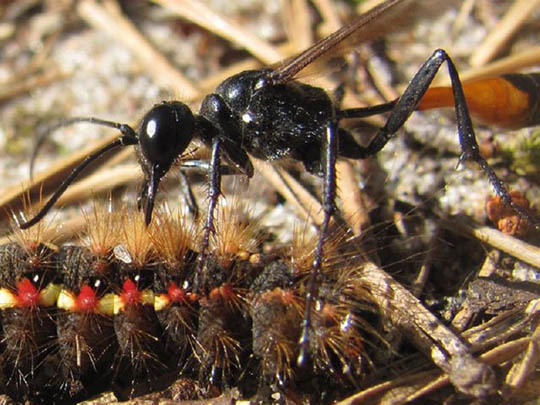

Scefidae
Betilids are represented by 1800 species, about a hundred of which are found in Europe. Their narrow body is 1-10 mm in length, there are no wings, so they are sometimes mistaken for ants. Pests such as cotton moth and grape leafworm become their victims and a breeding ground for larvae.
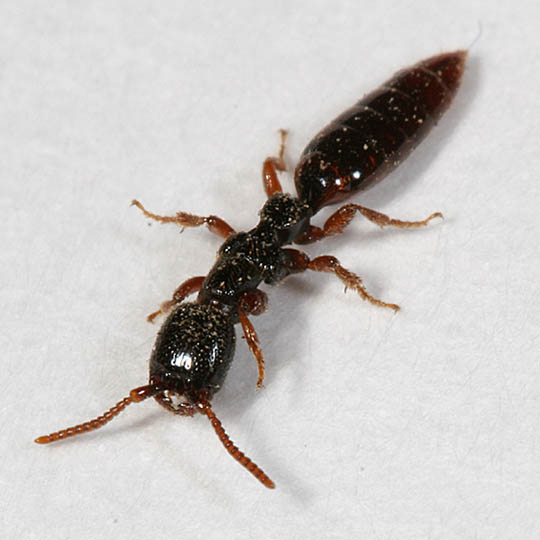

Bethylidae
Skolias are rather large specimens for wasppeople: their body length ranges from 2 to 10 cm, and their wingspan is up to 6 cm. Their habitat is predominantly in the tropics, but sometimes they are also found in forest-steppe zones. The body is black, with light stripes and spots on the abdomen; the wings are purple. Reproduction begins in May, and the female finds larvae of May beetles, weevils or rhinoceros beetles in the soil and makes a clutch on them. The larvae overwinter in the body of the victim, and pupation occurs in the spring.


Scoliidae
The emerald cockroach wasp is found mainly in the tropics. To lay eggs, the female uses a cockroach, before turning it into a real "zombie" with its bite. She drags a weak-willed cockroach by its mustache into a previously prepared hole, where it lays eggs in its body, and when the larvae hatch from the eggs, they feed on a live, but paralyzed cockroach from the inside.
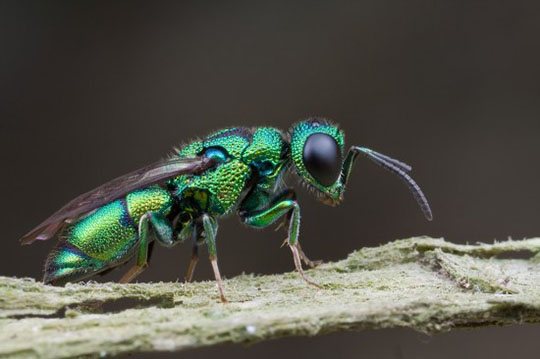

Ampulex compressa
Trichogramma is a microscopic variety, there are up to 200 species. The body is brown or black, dense, with antennae. Distributed on agricultural plantations.
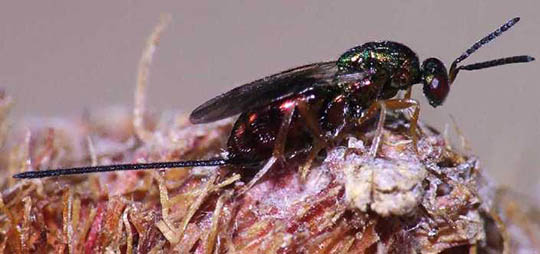

Trichogramma evanescens
The rider is yellow, 1.5-2 cm in size, inhabits forest glades and meadows. Most often found in summer and autumn.
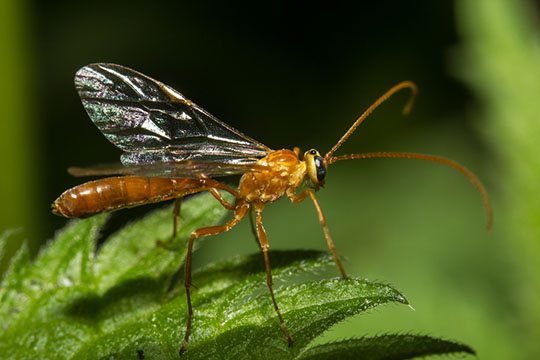

Ophion luteus
Eulofus
Such a parasitic wasp is an external group insect of the caterpillars of the winter moth, some specimens of butterflies, the antique wolf moth, leafworms, scoop, peppered moth, fruit moth and others. In different periods, the death of the winter moth caterpillars was noted by 27-37% of this parasite.
The size of an adult eulofus is not more than 2 mm. Its body is silvery. Pupae overwinter in groups near the remains of larvae, on fallen leaves, rarely - in the surface layer of the soil under the wood.
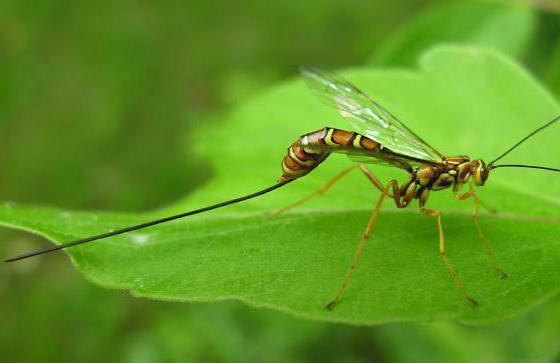

Beneficial insects, riders fly out of their cocoons after overwintering, in the second half of May, at the stage of mass flowering of cherries, pears, mid-ripening varieties of currants, apple trees, cherries and plums. The parasite's flight lasts approximately 2 weeks and ends by the beginning of the summer season. Eulophus are fed with nectar of weeds and flowers of fruit crops in garden plots. Since the caterpillars of the winter moth are absent in the garden at this time, the insects look for the larvae of other pests (leaf rollers, scoop) and infect them.
By August, the larvae of the new generation finish feeding, pupate, firmly fixing on the leaf, and at the end of the leaf fall they move to the winter hut in the fallen leaves or make their way into the surface layer of the earth.
What to do after being bitten
After a wasp attack, you need to disinfect the wound, neutralize the effect of the poison. Medical alcohol, ammonia, tincture of valerian, motherwort, hunger, calendula are used. Apply baking soda paste, soap foam, toothpaste, shaving foam to the sore spot. Rub it with aloe juice, chamomile decoction. Further actions depend on the clinical picture.
If a severe allergic reaction occurs, an antihistamine should be taken - Claritin, Diazolin, Fenistil, ElCet. Treat the skin with ointment, cream - Fenistil gel, Advantan, Elokom, Sinaflan, Triaccutane. Treatment should not exceed 5 days. Symptoms disappear in 2-3 days. In difficult situations, you need to seek help from specialists. Wasp riders living in our area rarely provoke severe allergies.
Panisk
These are large parasitic insects. The riders look like huge red mosquitoes, they fly towards the light of the lamp and are distinguished by short ovipositors. 40 species of night moths parasitize on caterpillars, including winter worms and scoops, which cause considerable harm to winter crops. They fix 3 eggs on the back of the caterpillars, and from them larvae soon hatch and snuggle tightly to the pests until the period when it is necessary to weave a pupa and pupate.
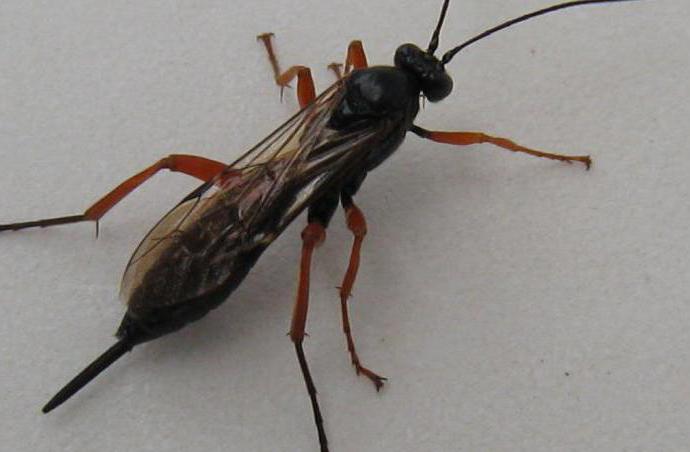

Maliciousness of creatures
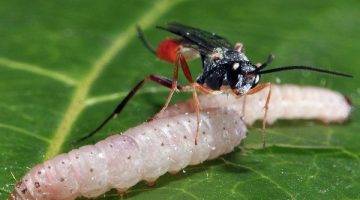

It's time to figure out whether the wasp wasp is dangerous for people. No, rather, on the contrary, these insects bring considerable benefit to humans, ridding plantations of bark beetles, gluttonous caterpillars and spiders. Individuals help protect forests and agricultural land by maintaining a natural balance. Many owners of backyard plots specifically attract creatures to their territory to combat harmful beetles and spiders.
Wasp riders are able to parasitize on a huge number of pests, killing them, and thus preventing damage to plantings. Protecting food barns and agricultural fields with their help reduces the amount of toxic chemicals, which significantly improves the ecological situation.
It is worth remembering, however, that some species of riders bite rather painfully, but their bites pose a potential threat only to allergy sufferers and children.
Basically, this kind of damage does not pose a threat to humans and is completely harmless, so you can safely attract creatures to fight the order of annoying garden pests.
Riesz
This type of rider has a large ovipositor. They infect wood-eating pests. The parasite is also common in Russian forests. The insect is black in color with yellow stripes on the abdomen and spots on the chest. They have a well-developed sense of smell, which helps them to detect barbel beetles and horntail beetles living under the bark of a tree in a depth of several centimeters. A rider (insect) drills a hole in the bark for a long time. Riesses lay their eggs directly in the passage eaten by the horntail larva. The larvae of these beneficial parasites feed first on the host's hemolymph, and then eat the internal organs.
Food
The terrible ways of feeding the larvae of such creatures are already clear. By the time they hatch from eggs and begin to develop, their parents have already made sure that they have enough food. After all, the organisms infected by them do not suffer significantly at once. They not only live, but grow, develop and feed, at first noticing little that a parasite is maturing inside them. But over time, a terrible fate awaits them.
For example, larvae from the braconid family, specializing in caterpillars, by the end of their formation leave only the skin of it, completely eating up all the insides of their host. At first, the developing parasites consume only fat, causing little damage to the host, but then organs important for life are used.
One way or another, absolutely all species of riders parasitize. But it is interesting that in some cases adults do not eat anything at all. However, others still need food. In this case rider eats or secretions from other insects, or nectar or pollen from plants.
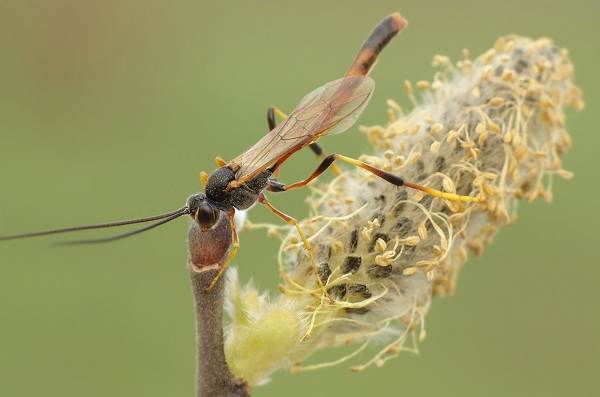

Afelinus, aphidiid, aphidius
They are small riders, parasitizing mainly on aphids. When an insect discovers aphids, it compresses the abdomen between its legs, quickly pierces it with the ovipositor and jumps back so that it does not spray it with the protective secretions of its tubes. Aphelinuses lay only 1 egg in aphids. Their larvae form in it, and over time, it turns into a mummy.


Description
The wasps differ from ordinary wasps by the absence of a sting as such; it is replaced by the ovipositor. Nevertheless, in the English-language literature, wasps are usually called parasitic wasps [3]. With the help of the ovipositor, wasps lay eggs in the body of larvae (caterpillars) or in the eggs of their victims. The victims are mainly larger insects, such as butterfly caterpillars, beetle larvae, as well as other arthropods, including some species of spiders. The rider typically sits over the victim (like a rider on a horse, hence the name) and introduces the ovipositor. The rider larvae hatch inside the prey and feed on their tissues and organs, gradually killing them. Species of the genus Megarhyssa
The superfamily of ichneumon wasps have a slender ovipositor several centimeters long, which is used for penetration into tree trunks.
There are several functional groups of parasitic hymenoptera, differing in the ways of parasitism [2].
- Ectoparasites, as a rule, infect hidden hosts developing inside fruits, galls, wood, and therefore attach their eggs outside, paralyzing prey.
- Endoparasites lay eggs inside the prey, and their larvae take longer to develop.
- Superparasites (parasites of parasites, or hyperparasites) infect other parasites (Hymenoptera or Diptera). Superparasites of the 3rd and 4th order are very rare, but nevertheless there are also superparasites [2].
The function of the ovipositor is preserved in some wasps (Dryinidae, Chrysididae, Sapygidae), as well as in Orussidae.
Ageniaspis
Considered one of the original designs. The rider (insect) specializes in infecting the egg of the apple moth, however, it does not mature for a long time, but is waiting for the development of the caterpillar itself. Then many twins emerge from this egg. From the eaten larva, 150-200 ageniaspis are hatched.
The record holder for fertility is a plastigaster. It mostly parasitizes the Hessian cereal fly. The female infects both juvenile larvae and eggs, laying up to 3000 eggs during her life.
Encarsia is no less popular, laying its eggs on the larvae of the greenhouse whitefly. It is propagated by almost all greenhouse agricultural firms.
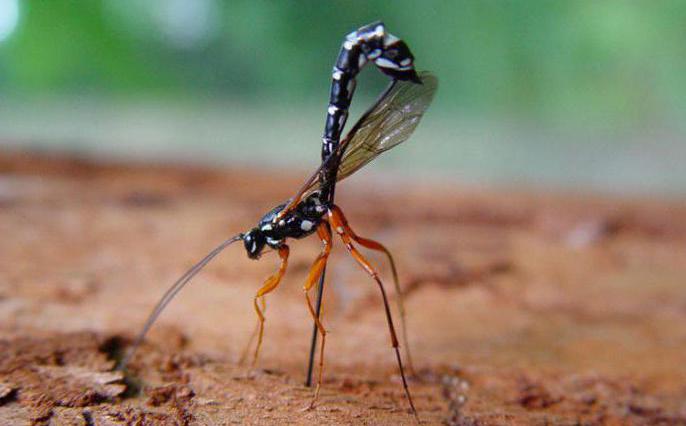

Features of the
The sizes of adults are from 2 millimeters to 4 and more centimeters. The abdomen is elongated, in females it has a long ovipositor (sometimes up to 17 centimeters). The head antennae are also elongated. The wings of most representatives are well developed.
After mating, females lay eggs directly on the body of the future host. Sometimes in the body or next to the prey insect. Some larvae are selective in choosing a host, others parasitize various insects. The death of the host occurs before pupation, less often after spring awakening. The rider injects special viruses into the victim's body to subdue the immune system. And at the same time diligently provides himself with fresh food.
The viability of the host is preserved, even if only a tenth of the mass of its internal organs remains intact.
Caterpillars, beetles, ants, wasps serve as food. Less commonly, spiders and scorpions. There are species parasitizing on tahini flies. This is the so-called secondary parasitism.
Adult riders are active at night and are very sensitive to humidity. They prefer to settle near water bodies. Here they can be found on flowering grasses. The population increases dramatically during rainy summers.
What beneficial parasites usually eat
Most species of such insects do not eat meat. An adult rider (insect) eats the nectar of flowers and hunts in order to procreate. There are mature individuals who do not eat anything at all. However, parasites are very fond of drinking, gathering near lakes and feasting on dew. They exist for no more than 2 months, some of them are evening or nocturnal insects. But at the same time, the favorite and main food of riders is:
- mealybugs;
- cicadas;
- sawflies;
- scabbards;
- aphid;
- bedbugs;
- pest butterflies;
- flies;
- whitefly;
- flares;
- beetles;
- blood aphid.
Many people will be interested to hear the answer to the question: "Is the insect rider dangerous for humans?" Absolutely not, and on the contrary, these parasites play an important role in nature, protecting garden plots with fruit trees and vegetables from the invasion of various pests.
Wasp classification
According to the way of living in a particular territory, earthen wasps are divided into social and single individuals. The former live in colonies and have a queen-queen in their composition, which lays eggs, as well as wasp workers, providing food, servicing the larvae and protecting the house. The second group is represented by solitary individuals that do not need to build nests. Every adult wasp can breed.
Paper wasps
This is a well-known group of insects with a classic black and yellow stripe. Wild wasps build circular nests that can be seen in attics or house walls. For the construction of a "dwelling" paper wasps use paper independently produced from wood. The bite of this wasp is not very painful compared to other species, however, it causes a slight burning sensation at the site of the wound localization.
Flower wasps


This group of insects is small in size with a body of no more than 1 cm. They eat pollen and flower nectar. Individuals create nests in the ground and on branches, usually make their houses from sand and clay, holding together "building materials" with saliva. Due to the nature of their habitats, they can be confused with classic bees, but their bite is painful and can provoke an allergic reaction.
Hornets


It is the largest representative among wasps leading a "social" lifestyle, is 55 mm in length. The hornet and the classic wasp differ in that it is a predator. The hornet kills insects with a sting and eats them, and the wasp eats plant food. Hornet bites, due to the structural features of their predatory jaw, are painful and can cause pain for several days.
"Shiny" wasps


This species of insects is especially beautiful, because it has a beautiful bright color with a shiny shade. This wasp is medium in size, but you can easily distinguish it from its fellows. The lifestyle of individuals differs in that they are parasites and use bees, butterflies, and other insects as sources of vital activity.
Road wasps
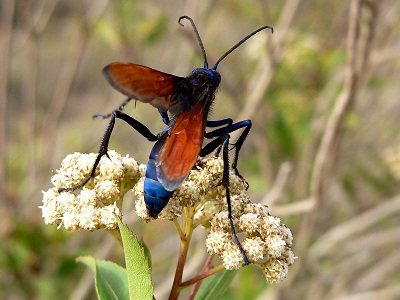

The road wasp is distinguished by the fact that it traditionally does not create a nest, but digs a hole in the ground. The road wasp, being in a larval state, feeds on spiders and insect stings, which are damaged by pricks from females and males. The bites of these individuals cause a tingling sensation in the affected area. Ground wasps are quite painful.
German Wasps


These individuals are interesting in that there are noticeable differences between representatives of males and females. The male is a large wasp, and the female is a small individual. The females in this colony do not have wings, but are outwardly fluffy and resemble ants. In this regard, they received the name "velvet ants". The bites of these individuals can bring quite a lot of discomfort.
Scoli
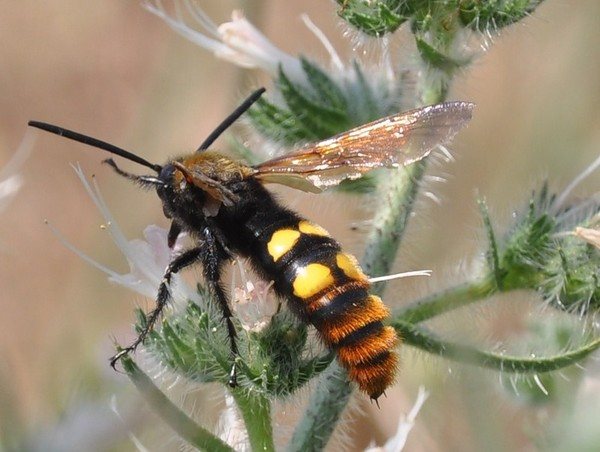

Scolia is usually a huge wasp with a body size of up to 10 cm, but smaller individuals can be found. Giant scolia has an attractive appearance; from a distance it can be confused with a butterfly. The scolia wasp is the largest member of this family in Europe. Oddly enough, the wasp of the scolia family does not pose any danger to humans, and its venom does not cause painful sensations when bitten. The larvae of this insect parasitize large beetles and lay eggs. An adult scoliosis wasp eats the nectar of flowers.


Typhia
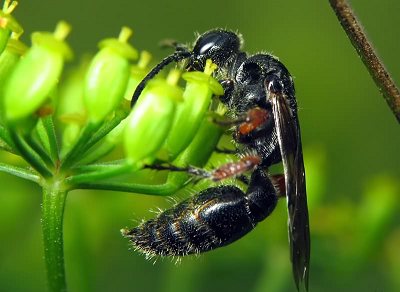

It is a black wasp that parasitizes June and May beetles.To search for larvae, these individuals can bury themselves in the ground. Killer wasps are not found among this group, but the bite causes unpleasant sensations, and in the presence of allergic reactions, it can do harm.
Rider
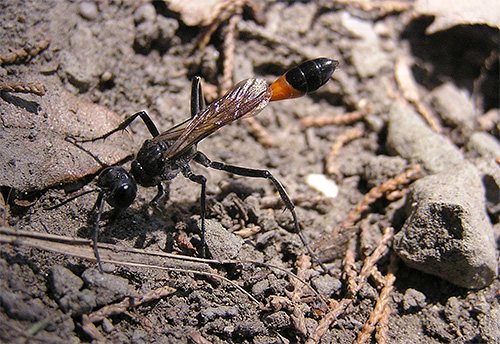

The wasp is a medium-sized individual. They include a group of wasps that differ in appearance and habitat. Some individuals are completely harmless, but there are more dangerous representatives.
Also in nature there are other representatives - a red wasp with a potent poison, a white wasp with characteristic external indicators. All of them are potentially dangerous to humans, so when you meet, you need to know how to behave.
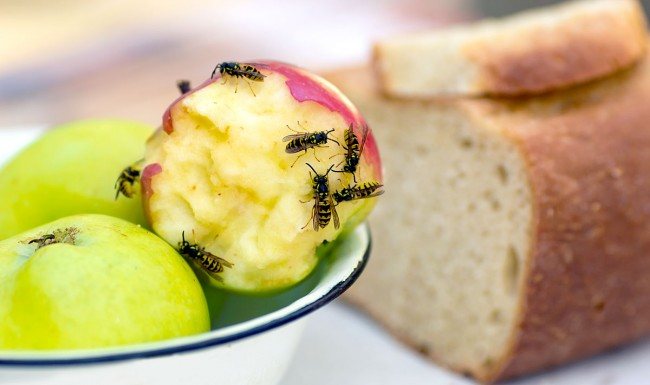

The wasp is one of the rare stinging insects that are difficult to classify, and the bite of the wasp is much more painful than the bite of many other insects. Scientists tend to classify wasps as stem-bellied stinging insects, unlike other species. There are many varieties of wasps. Basically, humans are attacked by the so-called collective wasps. The bite of a wasp is leafy for humans, not fatal, but painful. They belong to collective wasps, they arrange their nests in the immediate vicinity of a person's dwelling. A wasp sting of another species is unlikely.

